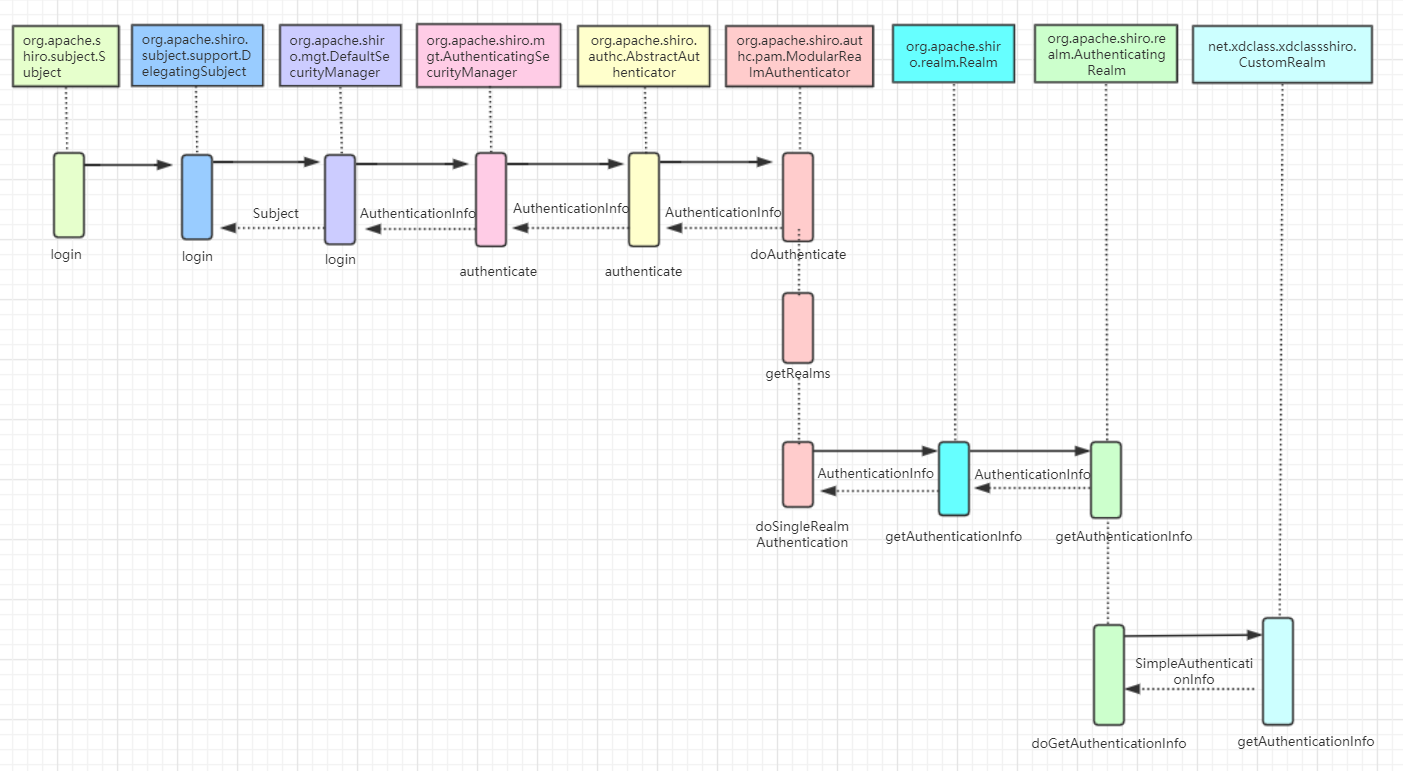1. 自定义Realm基础
- 步骤:
- 创建一个类 ,继承AuthorizingRealm->AuthenticatingRealm->CachingRealm->Realm
- 重写授权方法 doGetAuthorizationInfo
- 重写认证方法 doGetAuthenticationInfo
- 方法:
- 当用户登陆的时候会调用 doGetAuthenticationInfo
- 进行权限校验的时候会调用: doGetAuthorizationInfo
- 对象介绍
- UsernamePasswordToken : 对应就是 shiro的token中有Principal和Credential
-
UsernamePasswordToken-》HostAuthenticationToken-》AuthenticationToken
-
- SimpleAuthorizationInfo:代表用户角色权限信息
- SimpleAuthenticationInfo :代表该用户的认证信息
- UsernamePasswordToken : 对应就是 shiro的token中有Principal和Credential
2. 自定义realm代码:
package net.xdclass.xdclassshiro;
import org.apache.commons.lang3.StringUtils;
import org.apache.shiro.authc.AuthenticationException;
import org.apache.shiro.authc.AuthenticationInfo;
import org.apache.shiro.authc.AuthenticationToken;
import org.apache.shiro.authc.SimpleAuthenticationInfo;
import org.apache.shiro.authz.AuthorizationInfo;
import org.apache.shiro.authz.SimpleAuthorizationInfo;
import org.apache.shiro.realm.AuthorizingRealm;
import org.apache.shiro.subject.PrincipalCollection;
import java.util.HashMap;
import java.util.HashSet;
import java.util.Map;
import java.util.Set;
/**
* 自定义realm:继承AuthorizingRealm,重写抽象方法
*/
public class CustomRealm extends AuthorizingRealm {
private final Map<String, String> userInfoMap = new HashMap<>();
{
userInfoMap.put("jack", "123");
userInfoMap.put("xdclass", "456");
}
//role->permission 模拟数据库角色与权限的关系
private final Map<String, Set<String>> permissonMap = new HashMap<>();
{
Set<String> set1 = new HashSet<>();
Set<String> set2 = new HashSet<>();
set1.add("video:find");
set1.add("video:buy");
set2.add("video:add");
set2.add("video:delete");
permissonMap.put("jack", set1);
permissonMap.put("xdclass", set2);
}
//user->role 模拟数据库角色与权限的关系
private final Map<String, Set<String>> roleMap = new HashMap<>();
{
Set<String> set1 = new HashSet<>();
Set<String> set2 = new HashSet<>();
set1.add("role1");
set1.add("role2");
set2.add("root");
roleMap.put("jack", set1);
roleMap.put("xdclass", set2);
}
/**
* 校验权限时会调用这个方法,原理就是把角色和权限封装到SimpleAuthorizationInfo的实体中,shiro框架会帮我们进行权限的校验
* 最终org.apache.shiro.realm.AuthorizingRealm#hasRole(org.apache.shiro.subject.PrincipalCollection, java.lang.String)
* 方法会调用这个返回的simpleAuthorizationInfo
* @param principalCollection
* @return simpleAuthorizationInfo
*/
@Override
protected AuthorizationInfo doGetAuthorizationInfo(PrincipalCollection principalCollection) {
System.out.println("权限:doGetAuthorizationInfo");
//获取用户主账户名
String name = (String) principalCollection.getPrimaryPrincipal();
//通过名称查找权限,简化操作(正常是通过名称找角色,通过角色查询对应的权限)
Set<String> permissions = getPermissonsByNameFromDB(name);
Set<String> roles = getRolesByNameFromDB(name);
SimpleAuthorizationInfo simpleAuthorizationInfo = new SimpleAuthorizationInfo();
simpleAuthorizationInfo.setRoles(roles);
simpleAuthorizationInfo.setStringPermissions(permissions);
return simpleAuthorizationInfo;
}
private Set<String> getRolesByNameFromDB(String name) {
return roleMap.get(name);
}
private Set<String> getPermissonsByNameFromDB(String name) {
return permissonMap.get(name);
}
//用户登录的时候会调用该方法
@Override
protected AuthenticationInfo doGetAuthenticationInfo(AuthenticationToken authenticationToken) throws AuthenticationException {
System.out.println("认证: doGetAuthenticationInfo");
//从token中获取身份信息,token代表用户输入的信息
String name = (String) authenticationToken.getPrincipal();
//模拟从数据库读密码
String pwd = getPwdByUserNameFromDB(name);
if (StringUtils.isBlank(pwd)) {
//这里判断是必须要加的,返回null,即为认证不通过!!!详见源码
return null; //匹配失败
}
/*useNmaePasswordToken中有用户的Principal和Credential
SimpleAuthorizationInfo代表用户的角色权限信息
SimpleAuthenticationInfo 代表该用户的认证信息*/
// this.getName()是获取CachingRealm的名字
SimpleAuthenticationInfo simpleAuthenticationInfo = new SimpleAuthenticationInfo(name, pwd, this.getName());
return simpleAuthenticationInfo;
}
private String getPwdByUserNameFromDB(String name) {
return userInfoMap.get(name);
}
}
代码测试:
package net.xdclass.xdclassshiro;
import org.apache.shiro.SecurityUtils;
import org.apache.shiro.authc.UsernamePasswordToken;
import org.apache.shiro.config.IniSecurityManagerFactory;
import org.apache.shiro.mgt.DefaultSecurityManager;
import org.apache.shiro.mgt.SecurityManager;
import org.apache.shiro.subject.Subject;
import org.apache.shiro.util.Factory;
import org.junit.Before;
import org.junit.Test;
/**
* 自定义Realm操作
*/
public class QuicksStratTest5_4 {
private CustomRealm customRealm = new CustomRealm();
private DefaultSecurityManager defaultSecurityManager = new DefaultSecurityManager();
@Before
public void inint(){
//构建环境
defaultSecurityManager.setRealm(customRealm);
SecurityUtils.setSecurityManager(defaultSecurityManager);
}
@Test
public void testAuthentication() {
//获取当前操作的主体
Subject subject = SecurityUtils.getSubject();
//模拟用户输入账号密码
UsernamePasswordToken usernamePasswordToken = new UsernamePasswordToken("jack", "123");
subject.login(usernamePasswordToken);
System.out.println("认证 结果:" + subject.isAuthenticated());
System.out.println("getPrincipal()=" + subject.getPrincipal());
System.out.println("调用权限校验:subject.hasRole方法会调用自定义realm重写的doGetAuthorizationInfo方法");
System.out.println("用户jack是否有root角色:" + subject.hasRole("root")); //false
// 权限校验
subject.checkRole("role1");
System.out.println("用户jack是否有role1角色:" + subject.hasRole("role1")); //true
System.out.println("用户jack是否有video:find权限:" + subject.isPermitted("video:find")); //true
}
}
上面代码中 ,subject.login方法很关键,是所有认证授权逻辑的入口,跟踪一下代码,可以发现subject.login方法实际调用过程如下:

总结一下,shiro认证的主要流程就是
subject.login(usernamePasswordToken);
DelegatingSubject->login()
DefaultSecurityManager->login()
AuthenticatingSecurityManager->authenticate()
AbstractAuthenticator->authenticate()
ModularRealmAuthenticator->doAuthenticate()
ModularRealmAuthenticator->doSingleRealmAuthentication()
AuthenticatingRealm->getAuthenticationInfo() 需要注意的是:org.apache.shiro.authc.pam.ModularRealmAuthenticator#doAuthenticate 这个方法中,一般只配置一个realm,因此走的是doSingleRealmAuthentication 这个分支
protected AuthenticationInfo doAuthenticate(AuthenticationToken authenticationToken) throws AuthenticationException {
this.assertRealmsConfigured();
Collection<Realm> realms = this.getRealms();
return realms.size() == 1 ? this.doSingleRealmAuthentication((Realm)realms.iterator().next(), authenticationToken) : this.doMultiRealmAuthentication(realms, authenticationToken);
}
doSingleRealmAuthentication 分支源码如下:
protected AuthenticationInfo doSingleRealmAuthentication(Realm realm, AuthenticationToken token) {
if (!realm.supports(token)) {
String msg = "Realm [" + realm + "] does not support authentication token [" + token + "]. Please ensure that the appropriate Realm implementation is " + "configured correctly or that the realm accepts AuthenticationTokens of this type.";
throw new UnsupportedTokenException(msg);
} else {
// 这里实际上调用的就是自定义realmz中重写了的getAuthenticationInfo方法,如果返回null,抛出UnknownAccountException,认证不通过
AuthenticationInfo info = realm.getAuthenticationInfo(token);
if (info == null) {
String msg = "Realm [" + realm + "] was unable to find account data for the " + "submitted AuthenticationToken [" + token + "].";
throw new UnknownAccountException(msg);
} else {
return info;
}
}
}
在源码中,获取 AuthenticationInfo 认证信息,如果为空的话,抛出异常,这也是为什么自定义realm中 doGetAuthenticationInfo 方法中判断密码不正确时要返回null的原因;
doSingleRealmAuthentication 方法中的 AuthenticationInfo info = realm.getAuthenticationInfo(token) 调用了org.apache.shiro.realm.AuthenticatingRealm 类的getAuthenticationInfo(org.apache.shiro.authc.AuthenticationToken)方法,这个方法里面,调用了一行: info = this.doGetAuthenticationInfo(token),查找其实现类,就是我们自定义realm重写的的doGetAuthenticationInfo方法。
同理,shiro授权的主要流程如下:subject.checkRole方法是授权流程的入口
subject.checkRole("admin")
DelegatingSubject->checkRole()
AuthorizingSecurityManager->checkRole()
ModularRealmAuthorizer->checkRole()
AuthorizingRealm->hasRole()
AuthorizingRealm->doGetAuthorizationInfo()